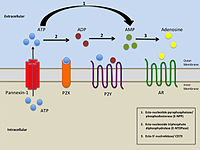
Photo from wikipedia
Adolescence is a sensitive and critical period in brain development where psychiatric disorders such as anxiety, depression and post-traumatic stress disorder are more likely to emerge following a stressful life… Click to show full abstract
Adolescence is a sensitive and critical period in brain development where psychiatric disorders such as anxiety, depression and post-traumatic stress disorder are more likely to emerge following a stressful life event. Females are two times more likely to suffer from psychiatric disorders than males. Patients with these disorders show alterations in orexins (also called hypocretins), important neuropeptides that regulate arousal, wakefulness and the hypothalamic-pituitary-adrenal axis activity. Little is known on the role of orexins in mediating arousal behaviors in male and female rats during adolescence or adulthood. Here, we examine the influence of orexin 1 receptor blockade by SB334867 in open-field behavior in male and female rats during early adolescence (PND 31-33) or adulthood (PND 75-77). Animals were injected with 0 (vehicle), 1, 10, or 30 mg/kg SB334867 (i.p.). Thirty minutes later, they were placed in an open field, and behavior and neuronal activity (c-Fos) were assessed. In adolescent males, SB334867 significantly increased immobility in the 10 mg/kg group compared to vehicle. However, this increase in immobility in adolescent males was not observed in adolescent females. In contrast to adolescent males, adult males in the 10 mg/kg dose group showed the opposite effect on immobility compared to vehicle. These results indicate that 10 mg/kg dose of SB334867 has opposing effects in adolescent and adult males, but few effects in adolescent and adult females. Differences in functional networks between limbic regions may underlie these effects of orexin receptor blockade that are sex- and age-dependent in rats.
Journal Title: Neuroscience
Year Published: 2018
Link to full text (if available)
Share on Social Media: Sign Up to like & get
recommendations!